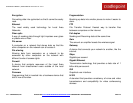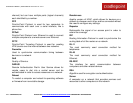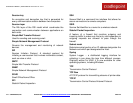
CRADLEPOINT IBR650 | USER MANUAL Firmware ver. 3.3.0
© 2011 CRADLEPOINT, INC. PLEASE VISIT HTTP://KNOWLEDGEBASE.CRADLEPOINT.COM/ FOR MORE HELP AND RESOURCES PAGE 126
10 APPENDIX
10.1 Product Information and Safety Guide
This important Product Information and Safety Guide contains safety, handling, disposal, regulatory, trademark, copyright, and software licensing information. Read all safety
information below and operating instructions before using the IBR650 3G device to avoid injury.
SAFETY AND HAZARDS
Under no circumstances should the IBR650 3G device be used in any areas (a) where blasting is in progress, (b) where explosive atmospheres may be present, or (c) that are near (i)
medical or life support equipment, or (ii) any equipment which may be susceptible to any form of radio interference. In such areas, the IBR650 3G device MUST BE POWERED OFF
AT ALL TIMES (since the device otherwise could transmit signals that might interfere with such equipment). In addition, under no circumstances should the IBR650 3G device be used
in any aircraft, regardless of whether the aircraft is on the ground or in flight. In any aircraft, the IBR650 3G device MUST BE POWERED OFF AT ALL TIMES (since the device
otherwise could transmit signals that might interfere with various onboard systems on such aircraft). Furthermore, under no circumstances should the IBR650 3G device be used by
the driver or operator of any vehicle. Such use of the device will detract from the driver or operator‘s control of that vehicle. In some jurisdictions, use of the IBR650 3G device while
driving or operating a vehicle constitutes a civil and/or criminal offense.
Due to the nature of wireless communications, transmission and reception of data by the IBR650 3G device can never be guaranteed, and it is possible that data communicated or
transmitted wirelessly may be delayed, corrupted (i.e., contain errors), or totally lost. The IBR650 3G device is not intended for, and CradlePoint recommends the device not be used in
any critical applications where failure to transmit or receive data could result in property damage or loss or personal injury of any kind (including death) to the user or to any other party.
CradlePoint expressly disclaims liability for damages of any kind resulting from: (a) delays, errors, or losses of any data transmitted or received using the device; or (b) any failure of
the device to transmit or receive such data.
Warning: This product is only to be installed by qualified personnel!
To comply with FCC/IC regulations limiting both maximum RF output power and human exposure to RF radiation, the maximum antenna gain must not exceed 5 dBi in the Cellular
band and 4 dBi in the PCS band.
ANTENNA CONSIDERATIONS
Although the antenna model(s) used with these devices meet(s) the Industry Canada Radio Frequency requirements, it is possible that the future customers may swap them for
different ones without network providers knowledge and approval. Such customers must be made aware of, and follow, the Radio Frequency requirements applied in the Technical
Approval:
• RSS-102 ―Radio Frequency Exposure Compliance of Radiocommunication Apparatus (All Frequency Bands)‖
• RSS-129 ―800 MHz Dual-Mode CDMA Cellular Telephones‖
• RSS-132e ―Cellular Telephones Employing New Technologies Operating in the Bands 824-849 MHz and 869-894 MHz‖
• RSS-133 r1 ―2 GHz Personal Communications Services‖
FEDERAL COMMUNICATION COMMISSION INTERFERENCE STATEMENT
This equipment has been tested and found to comply with the limits for a Class B digital device, pursuant to Part 15 of the FCC Rules. These limits are designed to provide reasonable
protection against harmful interference in a residential installation. This equipment generates, uses and can radiate radio frequency energy and, if not installed and used in accordance
with the instructions, may cause harmful interference to radio communications. However, there is no guarantee that interference will not occur in a particular installation. If this
equipment does cause harmful interference to radio or television reception, which can be determined by turning the equipment off and on, the user is encouraged to try to correct the
interference by one of the following measures:
• Reorient or relocate the receiving antenna.
• Increase the separation between the equipment and receiver.


















